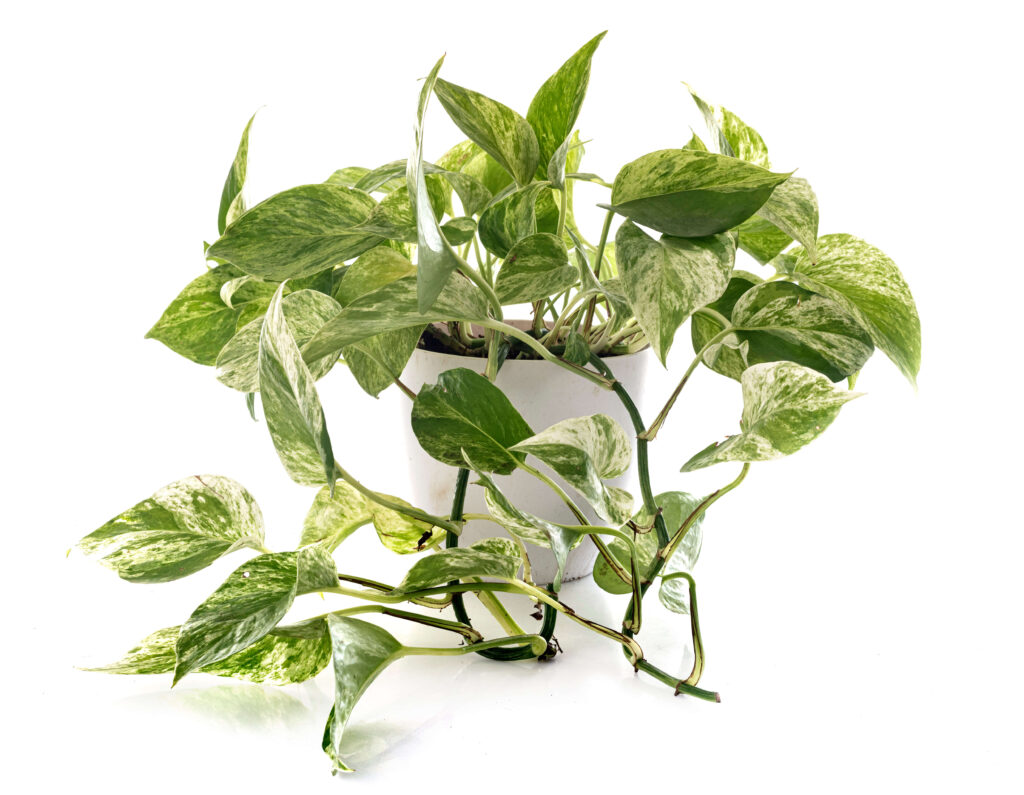“Complete Guide to Growing and Caring for Marble Queen Pothos: Expert Tips for Thriving Indoor Plants”

Introduction.
Marble Queen Pothos is a type of the well-known Pothos plant, which is scientifically referred to by the scientific name of Epipremnum aureum. This exotic beauty is adored by its varied leaves with striking patterns of cream, white and green. It is native to Southeast Asia and the Solomon Islands and the Solomon Islands, it is often called Devil’s Ivy because due to its robust nature and capacity to flourish in a variety of conditions.As an example of a low-maintenance plant category the Marble Queen Pothos is ideal for those seeking to decorate indoor space in house without much effort. It’s also an excellent option to decorate spaces such as hangers, shelves for books or tabletops.
Light Requirements for Marble Queen Pothos.
Light is an important element to keep the Marble Queen Pothos beautiful and healthy. The species thrives under moderate or bright indirect lighting. While it is tolerant of dim light conditions, it’s growth could slow down and the pattern on the leaves might fade.Place your plant in front of an east or west-facing window, where it will get intense, filtering sunlight. Do not expose the plant to direct sunlight because it could scorch fragile leaves. If you’re cultivating Marble Queen Pothos inside a dimly lit area, consider adding an artificial light source to keep its beautiful appearance.
Watering Schedule.
When it concerns watering the most important thing is to find the right balance. Overwatering can cause the root to rot and underwatering could cause the leaves to fall. The best method is to water your plants whenever the top 2 inches of soil feels dry and dry touch.During the growth time (spring as well as summer) you might need to water more frequently because the plant grows. In winter, you need to reduce the amount of watering you give your plant as its growth slows. Make sure the container is equipped with drainage holes to prevent water from building up in the bottom.
Soil Requirements.
A healthy soil is the base of a flourishing Marble Queen Pothos. Choose the well-draining potting mix that is able to hold some moisture but doesn’t remain wet. Mixing standard homeplant soil and perlite or sand is a good choice. This ensures adequate air circulation that is essential for a plant’s roots.If you’re planning to repot, select an area that’s just a bit larger than the existing one to avoid over-saturated soil that can absorb excessive water and cause root issues.
Humidity and Temperature.
Marble Queen Pothos is an exotic plant, which is the reason it can tolerate moderate to extremely extreme levels of humidity. While it can adapt to the typical indoor humidity levels and even increase humidity, it is essential to ensure that the conditions are suitable for the plant to thrive. Install a humidifier, place an ice tray close to the plant, or put it in a grouping plant in order to boost humidity levels in the air.As to temperature the plant thrives at temperatures that range between 65 degF-85 degF (18degC all the way to 28 degrees Celsius). Be cautious when exposing it to freezing temperatures or sudden fluctuations in temperature, which can stress the plant.
Fertilizer for Marble Queen Pothos.
Feeding your marble queen Pothos will help to ensure healthy growth and aid in maintaining its vibrant color. In spring and summer, it is recommended to feed the plant using an rich, nutrient-rich liquid fertilizer which is balanced and reduced by half every four to six weeks. Be aware not to over fertilize so as to avoid creation of sodium salts within soil, which could cause harm to the roots. Winter is the time to not fertilize. (fall and winter) it is not possible to fertilize because of the fact that plants’ requirements for nutrients decrease.
- One of the great things that Marble Queen Pothos is the ease with which it is to spread. If you’re looking to pass it on to a group of friends or grow your collection the propagation procedure:
- Select a healthy stem Choose a stem that has at least 3 leaves and an obvious node (the tiny bump on which roots develop).
- Cut below the Node: Use sterilized cutting tools or pruning shears for an uncut cut right beneath the node.
- Place the cutting in water or in soil The cutting should be placed in water, making sure your node’s submerged. Alternately, you can place it directly in the soil.
- Let the roots grow In water, roots will develop within a couple of weeks. When the roots are approximately 2-inches long you are able to move the cutting into soil.
Common Pests and Diseases.
The Marble Queen Pothos generally is immune to pests and diseases. But it’s important to keep an eye out for signs of trouble like:
- Mealybugs and Spider Mites: These bugs can be eliminated with the application the use of cotton pads which is dipped in rubbing alcohol or applied insecticidal soap.
- Root Rot: The most frequently cited reason for root rot. Make sure you rid the area of water and only make use of water when necessary.
- Leafs that are yellowing: It could indicate the presence of water, underwatering or nutrient deficiency. Check your routine of care to determine the cause.
Monitoring your plant on a regular basis and taking care of it can prevent the majority of problems.
Pruning Tips for a Healthy Plant.
Pruning is a crucial component of maintaining your plants to Marble Queen Pothos. Pruning your plants regularly helps increase the size of your plant and eliminates the damaged or yellowed leaves. Make sure you use sharp, clean scissors to cut just over the node to promote the growth of new plants. Pruning will also keep your plant from growing overly large or abrasive.
Is Marble Queen Pothos Safe for Pets and Humans?
While marble queen Pothos is beautiful it’s crucial to be aware that it’s harmful to pets as well as human ingestion. It is a major mineral source for calcium oxide crystals that can cause irritation, vomiting, and problems swallowing. Be sure to keep it safe from the reach of pets and children to ensure their safety.

Decorating with marble queen Pothos.
With its vines that trail and lush foliage the Marble Queen Pothos is an extremely versatile plant to decorate your home. Here are some suggestions:
- It can be planted within the hanging baskets/containers to create an effect of cascading.
- Let it scale the moss pole to create an indoor display.
- Place it on a bookcase or tabletop to add a splash of greenery.
Its flexibility makes it a preferred choice for both traditional and modern interiors.
Final Thoughts.
Marble Queen Pothos is more than just an interior plant. It’s a striking piece that will add vitality to any room. Due to it’s low maintenance requirements along with its amazing color range and ability to purify the air, it is no wonder this plant is a favorite among those who are indoor gardeners across the USA. If you adhere to the guidelines for taking care in this article, it’s possible to maintain an energized and healthy marble queen Pothos for many years to come. So regardless of whether you’re an experienced gardener or just beginning your journey towards green. This plant will surely bring beauty and happiness to your home. Enjoy your growth!

Hi! My name is imran a dedicated gardener and lover of plants determined to bring the pleasure of gardening to everyone. With over a decade of knowledge, I’ve studied a range of questions that range from organic gardening techniques to the latest advancements in the area that concerns house plants. The site is an most reliable source to start your own private garden, regardless of the level of expertise you have. Join me in celebrating natural beauty and the art of gardening form!
